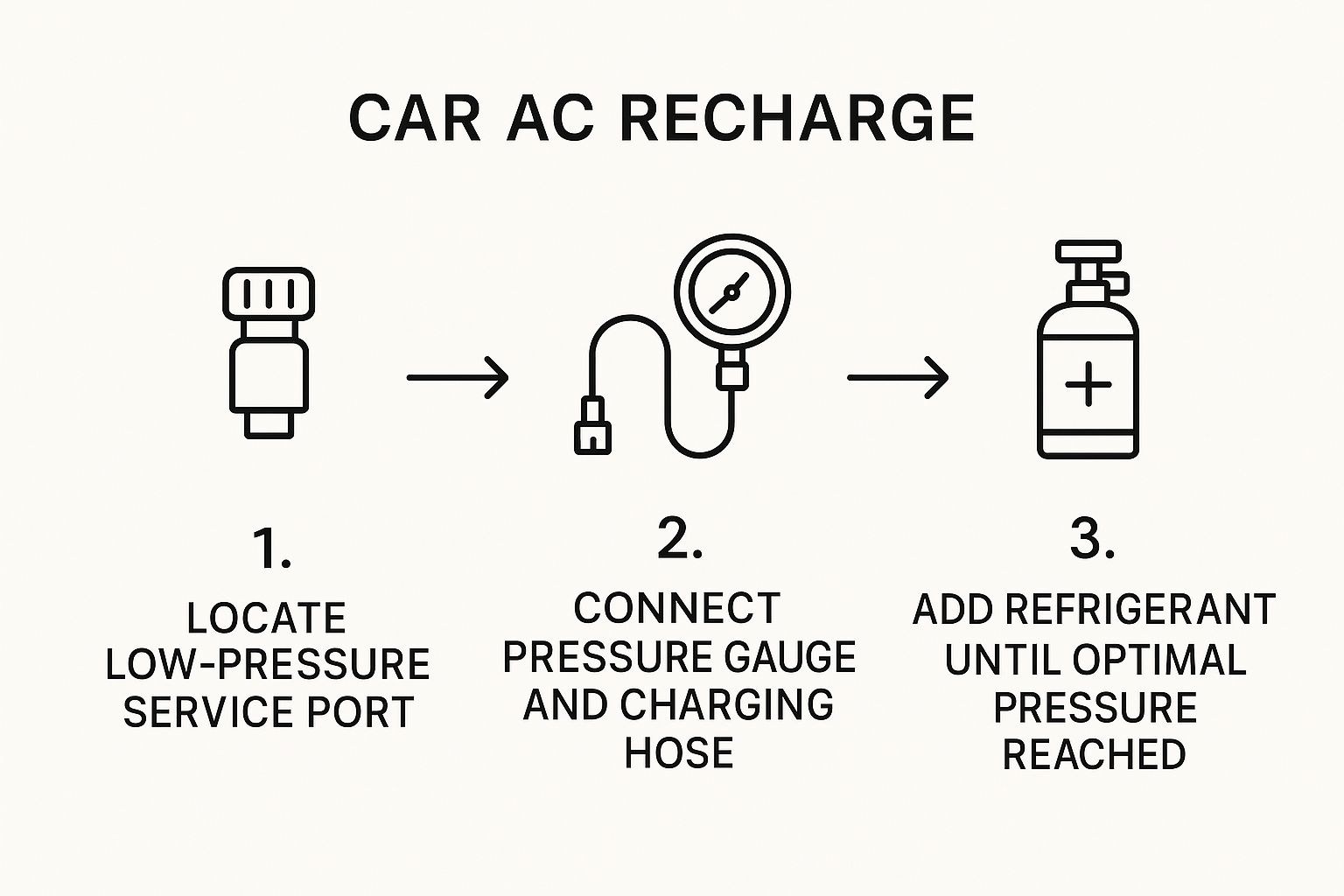Before scheduling an AC recharge for your car, it's beneficial to understand the system's components. Your car's AC isn't just a magical cold-air producer; it's a complex system of interacting parts. These key components include the compressor, condenser, evaporator, and expansion valve. Their coordinated operation transforms warm, humid air into the cool air that keeps you comfortable while driving.
The compressor, like the heart of the system, circulates the refrigerant. This refrigerant absorbs heat from inside your car. Then, the condenser, typically located at the front of your vehicle, releases this absorbed heat to the outside. This explains why you might feel heat coming from the front of your car when the AC is running.
The now-cooled refrigerant then travels to the evaporator. Here, it absorbs heat from the air blown across it by the blower motor, cooling the air directed into your cabin. Finally, the expansion valve regulates the refrigerant's flow and pressure, ensuring a continuous cooling cycle. The entire process depends on the correct refrigerant level. Insufficient refrigerant hinders the system's ability to absorb and release heat effectively.
This complex system requires regular care and maintenance. For more information, check out this helpful resource: How to master your AC. Beyond individual car owners, the automotive refrigerant market plays a significant role in the global economy. Valued at USD 55.11 billion in 2024, it's projected to reach USD 98.96 billion by 2033. This growth is partly fueled by the shift towards more eco-friendly refrigerants like R-1234yf. Automotive Refrigerant Market provides more detailed statistics.
Understanding refrigerant's role is key to understanding why an AC recharge might be necessary. Refrigerant isn't consumed like fuel; it continuously cycles through the system. However, small amounts can leak over time, diminishing cooling performance. This is when an AC recharge becomes essential. Proper AC maintenance is a specialized area within the broader HVAC services industry. Learning to recognize low refrigerant signs is crucial for preventing bigger problems.
These signs can include:
Ignoring these signs can result in more extensive and expensive repairs later. Understanding your car's AC system and the vital role of refrigerant allows you to address potential issues proactively, ensuring your comfort and the longevity of your car's cooling system.
Is your car's AC blowing lukewarm air instead of a refreshing chill? This is a telltale sign that your car might need an AC recharge. Beyond this obvious indicator, other subtle hints can point to a low refrigerant level. Recognizing these signs can save you from major discomfort down the road.
Much like a person suffering from dehydration, a car's AC system with low refrigerant will show noticeable symptoms. You might experience weak airflow from the vents, even at the highest fan setting. Unusual noises, such as hissing or clicking from under the hood, can also indicate a potential refrigerant leak or pressure problems within the system. Another sign is difficulty dehumidifying; if your windows fog up even with the AC running, your system likely needs attention.
Refrigerant is essential for a functioning car AC. It absorbs heat from inside your car and releases it outside, creating that cool air we all appreciate. However, refrigerant can leak over time, especially in older vehicles. This gradual loss diminishes the system's cooling efficiency. Less refrigerant simply means less cooling power, leading to an uncomfortable cabin, especially during summer's heat. Moreover, running a low-refrigerant system strains other AC components, potentially causing more expensive repairs later.
The increasing need for efficient AC systems is more than just anecdotal; it's a significant market trend. The automotive air conditioning compressor market, for instance, is expected to grow significantly. Projections show an increase from USD 10.4 billion in 2025 to USD 15.6 billion by 2035, a CAGR of 4.1%. This growth is driven in part by rising incomes in developing countries, leading to increased car ownership and higher demand for vehicles with dependable AC. You can find more statistics here: Automotive AC Compressor Market Growth

While some car owners try DIY AC recharges, knowing when professional help is necessary is crucial. If your system is simply low on refrigerant, a recharge might be enough. However, if a leak or other underlying problem is suspected, consult a qualified technician. They possess the expertise and tools to accurately diagnose and fix complex AC issues, restoring your system to peak performance. Addressing these problems early can prevent more extensive and expensive repairs in the long run.

Successfully recharging your car's AC involves more than just adding refrigerant. It requires the right tools. This section covers the essentials, outlining the must-haves and helpful additions for a smooth and effective recharge.
Several tools are absolutely crucial for a safe and successful car AC recharge. A refrigerant identifier helps determine the correct type for your vehicle, either R-134a or R-1234yf, preventing potentially damaging mistakes. You'll also need a recharge kit designed for your vehicle's specific refrigerant. These kits typically include a pressure gauge and a charging hose.
The pressure gauge allows for accurate measurement of refrigerant levels, preventing overcharging, a common issue with DIY recharges. Protecting yourself is paramount. Safety glasses and gloves are non-negotiable. Refrigerant can irritate skin and eyes, so these precautions minimize risks. Finally, a leak detector is essential for pinpointing any leaks after recharging. Addressing leaks prevents future refrigerant loss and maintains efficient cooling.
While not strictly necessary, a few extra tools can significantly improve the recharge process and your AC's performance. A fin comb, for example, straightens bent condenser fins, improving heat exchange and boosting cooling power.
A thermometer is another handy tool. It allows you to monitor the air temperature coming from the vents, confirming the recharge's effectiveness and helping diagnose potential issues beyond low refrigerant.
Using the correct refrigerant is paramount. Older vehicles typically use R-134a, while newer models generally use R-1234yf. Using the wrong type can severely damage your AC system, resulting in costly repairs. Always verify your car's refrigerant type before buying a recharge kit. If you're unsure, a professional technician can help.
To help you choose the best tools for your needs, take a look at this comparison table:
Before you begin, let's take a look at the essential AC recharge tools available. The following table summarizes the key features, price ranges, and best uses of each:
Essential AC Recharge Tools Comparison This table compares different types of AC recharge kits and tools available for DIY car maintenance, highlighting their features, price ranges, and suitability for different experience levels.
| Tool/Kit Type | Average Price Range | Features | Best For | Limitations |
|---|---|---|---|---|
| Basic Recharge Kit | $30-$60 | Hose, gauge, refrigerant | Beginners | Limited features, may not detect leaks |
| Professional Kit | $100-$200 | Multiple refrigerants, detailed gauge, leak detector | Experienced DIYers | Higher cost |
| Refrigerant Identifier | $20-$40 | Determines refrigerant type | All users | Doesn't perform the recharge itself |
| Leak Detector | $30-$80 | Identifies leaks | All users | Requires separate purchase from recharge kit |
As this table demonstrates, the best tool for you depends on your budget and experience level. While a basic kit is suitable for beginners, more advanced users might prefer a professional kit with additional features.
A successful car AC recharge isn't simply about adding refrigerant. It's about understanding the process, using the right tools, and prioritizing safety. With the necessary equipment and careful attention, you can effectively recharge your car's AC and enjoy cool, comfortable drives.
Recharging your car's AC system might seem intimidating, but with the right guidance, it's a DIY project you can handle. This guide breaks down the process into easy-to-follow steps, helping you restore cool air to your vehicle. Before you begin, prioritize safety. Always wear safety glasses and gloves when handling refrigerant.
The first step is finding your car's low-pressure service port. This port, typically capped and marked with an "L", is the connection point for the recharge hose. The location varies depending on the vehicle's make and model. Check your owner's manual or search online for specific instructions for your car. Connecting to the wrong port can damage your AC system, so accuracy is vital.
After locating the low-pressure service port, connect the pressure gauge and charging hose from your AC recharge kit. Ensure a tight connection to prevent refrigerant leaks. A secure seal is crucial for accurate pressure readings and effective recharging.
With the gauge and hose connected, you're ready to add refrigerant. Resist the urge to add it all at once. Instead, add the refrigerant in small, measured amounts, checking the pressure gauge frequently. This controlled approach allows you to monitor the system and prevent overcharging.

The infographic above illustrates the three main steps: locating the service port, connecting the equipment, and adding refrigerant gradually.
Knowing when to stop adding refrigerant is essential. Your car's AC system operates within a specific pressure range. Overcharging can damage the compressor and other parts. Consult your owner's manual or a pressure chart for your vehicle’s make and model to determine the correct pressure range. For more in-depth information, check out this resource on car AC repair: How to master car AC repair.
The increasing popularity of electric vehicles (EVs) is impacting the AC market. The global EV AC charger market is currently valued at approximately US$7.5 billion and is projected to reach US$36 billion by 2030, growing at a CAGR of about 29.9%. This growth underscores the rising demand for EV charging infrastructure. Learn more about this trend here: EV AC Charger Market Growth
Various factors can influence the AC recharge process. Ambient temperature affects pressure readings, so keep this in mind when referencing pressure charts. System resistance and temperature fluctuations can also occur. If you run into problems, consulting a qualified technician is always a good idea.
To help you achieve the correct refrigerant levels, refer to the table below for target pressure readings based on your vehicle type and the ambient temperature.
AC Refrigerant Pressure Guide by Vehicle Type This table provides target pressure readings for different vehicle makes and models, helping DIYers achieve the correct refrigerant levels during the recharge process.
| Vehicle Type | Ambient Temperature | Low Side Pressure (PSI) | High Side Pressure (PSI) | Notes |
|---|---|---|---|---|
| Compact Car | 70°F (21°C) | 25-35 | 150-250 | These are example values and may vary. Consult your owner's manual for specific recommendations. |
| Sedan | 80°F (27°C) | 30-40 | 175-275 | |
| SUV | 90°F (32°C) | 35-45 | 200-300 | |
| Truck | 100°F (38°C) | 40-50 | 225-325 |
This table offers a general guide. Always refer to your vehicle's specific requirements for accurate pressure readings.
By following these steps and understanding your car's AC system, you can successfully recharge your AC and enjoy comfortable, cool drives.
Even with the best preparations, AC recharges can sometimes present unexpected challenges. This section tackles some of the most perplexing problems DIYers encounter and offers solutions based on the insights of experienced professional technicians.
One of the most frequent issues is overcharging the system with refrigerant. Adding refrigerant seems simple enough, but exceeding the recommended pressure can seriously damage the compressor, the core of your AC system.
Overcharging shows up in a few ways. You might see unusually high pressure on your gauge, or the AC might cycle on and off too quickly. A loud groaning noise from the compressor is another sign – a clear indication of stress.
If you think you’ve overcharged the system, stop adding refrigerant immediately. The next step is carefully releasing some of the excess refrigerant. This requires caution, and ideally, the guidance of a qualified technician. Releasing too much can lead to undercharging, but not releasing enough will continue to damage the system.
Another common hurdle is finding refrigerant leaks. These leaks can be tiny and hard to spot. Professional leak detectors offer the most accurate detection, but DIY methods can also help.
One method uses soapy water. Apply it to the AC connections and watch for bubbles. Bubbling indicates a leak. Temporary fixes, like sealant products, can sometimes stop minor leaks until a permanent repair is possible. For larger leaks, however, professional repair is always the best course of action.
Interpreting pressure readings can be confusing. Low pressure often suggests the need for an AC recharge, but other factors can affect pressure too. Ambient temperature, for instance, has a significant impact. High ambient temperatures result in higher pressure readings, even with the correct refrigerant level.
Blockages in the system can also cause unusual pressure patterns. If your pressure readings are outside the normal range for your car, consider these other factors before assuming you need more refrigerant. This can prevent unnecessary recharges when the real problem lies elsewhere, like a malfunctioning compressor or another component. Understanding these nuances empowers you to make smart decisions about your car's AC, saving you both time and money.

Regular AC recharges are essential, but consistent maintenance is the key to optimal cooling and a longer lifespan for your car's AC system. This section reveals professional secrets to keeping your car cool and comfortable, minimizing those frequent AC recharge trips. These tips go beyond the basics, offering valuable insights that can save you money and headaches down the road.
Just like regular oil changes are vital for your engine, simple maintenance practices can significantly improve your AC's performance. One often-overlooked practice is running your AC for a few minutes every month, even in winter. This circulates the refrigerant, lubricating the system and preventing seals from drying out and leaking.
Regularly cleaning your cabin air filter is also crucial. A clogged filter restricts airflow, reducing cooling efficiency and potentially bringing unwanted odors into your car. It's like trying to breathe through a stuffy nose – a dirty filter makes it harder for your AC to deliver that refreshing cool air. For a more comprehensive car maintenance guide, check out this helpful resource: How to master your car maintenance checklist.
Experienced mechanics emphasize the importance of early problem detection. Pay attention to even subtle changes in your AC's performance. Is the airflow weaker than usual? Are there any unusual noises? Does the air smell musty? These seemingly small issues can be early warning signs of bigger problems. Addressing them quickly can prevent more extensive and expensive repairs later on. When troubleshooting, remember that effective system maintenance starts with understanding the design. For more insights on design principles, consider these form design best practices.
Your AC maintenance should also factor in your local climate. In hotter climates, more frequent checks and cleaning are recommended because of increased system use. Even in milder climates, however, seasonal inspections are important to catch potential problems early. This proactive approach ensures your AC is ready to perform when you need it most. Interestingly, the Asia-Pacific region holds a substantial 45.80% share of the automotive refrigerant market, driven by high vehicle production and consumption in countries like China and India. You can find more detailed statistics here: Automotive Refrigerant Market Share
By following these professional maintenance techniques, you can maximize your car's AC performance, reduce the need for frequent recharges, and enjoy a comfortable driving experience all year round.
Ready to experience the Kwik Kar difference? Visit Kwik Kar Oil Change and Auto Care today for all your car maintenance needs, including professional AC service. Our skilled technicians provide expert care to keep your car cool and comfortable throughout the year.

Get upto $20 OFF on all services.